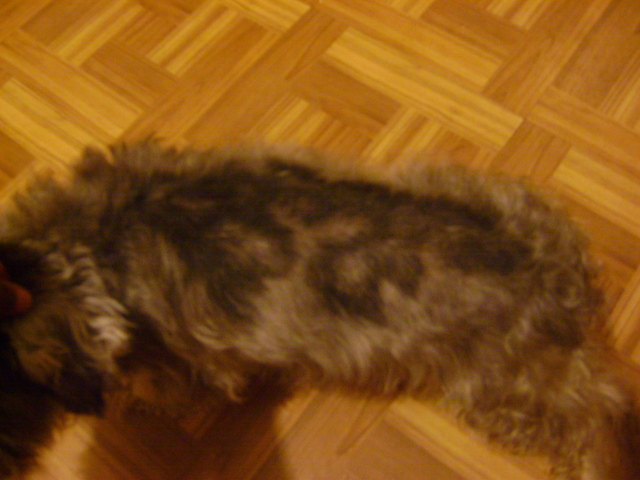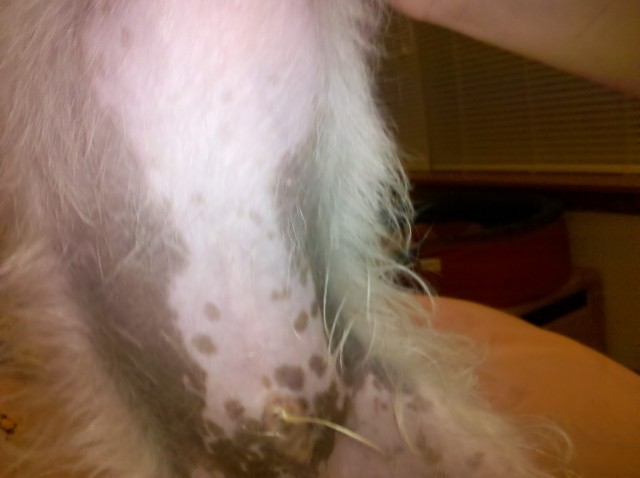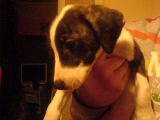QuestionWe will be getting a new puppy this weekend, and we have a older lab mix (he was a rescue and think he is about 7-9 yrs old), he has been the only dog and is very spoiled, what is the best way to indroduce a new puppy. We tried to choose a puppy that is as low keyed as possible, we are getting a basset hound, she is 7wks old. Also if you could tell me what the best puppy food for a basset puppy to eat, the vet the puppy has been to has recommended purnia large breed puppy food.
AnswerHi, Lisa, and thanks for asking! First things first, when you bring your new puppy home, you should keep her at home until she has had her round of three puppy shots, which are given at 9, 12, and 16 weeks of age. Another is given at 1 year old, and I, personally, do not give my dogs any more for the rest of their lives, unless they have a supressed immune system. Rabies is usually given between 3 and 6 months of age, and is the only thing I give boosters for, because it is required by law every 3 years. The reason for keeping her at home is because of the risk of her contracting parvo. Parvo is a virus that is spread when a puppy comes in contact with an infected dog's feces, or when the puppy enters an area where an infected dog may have passed through. Parvo can live in the environment for as long as 6 months and can be deadly to puppies.
You asked what is the best way to introduce the new puppy to your existing dog. It shouldn't be all that difficult, but you will want to start out slow and gradual, just in case. Start out by keeping them separated via a baby gate, to see how he's going to react to her. If he's friendly and interested, then you can allow them to interact under supervision. If he is apprehensive, then do not let them interact without the baby gate between them until he is more comfortable with her being there. You can also switch their beds around so that they get used to smelling each other. Never leave them alone together until she is older and you know for a fact that they are okay with each other and can get along. I recommend getting a crate and teaching her to sleep in it at night and when you are not at home. It should be large enough for her to stand up, lie down, and turn around in as an adult. Most crates come with divider panels now, so you can buy the adult size and use the divider to keep it small enough for her now and as she grows. If a crate is too large, she will use one end to potty in and the other to sleep in, and this is not good.
Puppies cannot hold their bladders for very long, so be prepared to have to clean up after her until she gets a little older. The general rule with puppies is that they can hold it for about as many hours as they are months old. At 7 weeks, your puppy will be almost 2 months old, so she would need to be let out to pee every 2 hours. If you work during the day, then that isn't going to happen, so I suggest getting a puppy playpen and encircling her crate with it in the kitchen or somewhere that has linoleum or another easy-to-clean floor surface. When she reaches 6 months old or so, you should be able to do away with the playpen and start leaving her in the crate during the day to break her from using the bathroom on the floor. Another option is to build or buy a pen to keep her in outside during the day until she's old enough to be able to hold it all day inside the house, but you'll still have to use the crate during the day when you first start letting her stay inside all day to ensure that she doesn't get into the habit of 'going' inside. At night, right now, you should plan on getting up once or twice to let her out so she doesn't potty in her crate.
Now, on to the food part of your question! I do not recommend Purina foods, because they are full of fillers, allergens, and grains. Vets go to school to learn how to treat injuries and diseases; they learn very little about nutrition, often taking only one short class on it that is sponsored by one of the big companies like Purina and Hill's (which makes Science Diet), so they really do not know all that much about nutrition. On top of that, they get a commission, or kickback, from the company whose food they sell in their clinics, so of course they're going to push whatever brand they are carrying behind their own desk. Usually it's Science Diet or Purina. Below, I have attached my article on dog foods. Please take the time to read over it; it's long but very informative and easy to understand. I've also given many food recommendations. Please feel free to ask if there's anything I need to elaborate on, or if you have any more questions! Good luck with your new puppy!
Kristen
Dog Foods - How to Choose?
The topic of dog food is a heated one amongst dog owners. Some people believe that dog food is dog food, and buy the cheapest brand available, because, well, their dog is doing just fine, thank you! There are others that believe the most expensive brand is better because it costs more, so it must be, right? Neither of these people are correct. Saying "dog food is dog food" would be like saying "McDonalds food or TV dinners are equivalent to a meal at an expensive restaurant". However, saying that "the most expensive brand is the best just because it costs more" is like saying that a $10 hamburger and fries meal at a restaurant is more nutritious than a $2.99 Happy Meal."
The key to choosing the right dog food is to know how to read the label. The most expensive food isn't always the best, but a store-brand is most certainly not as good as a holistic, all-natural brand either. In this post, I will attempt to give you some insight as to how to read a dog food label, and what to look for and avoid when making your choice.
Price really shouldn't be a factor, because after you've been feeding a better-quality food for a month or two, you'll begin to notice that your dog will require less of the better food since it will be more nutritious, so you'll be feeding him less. As a result, the amount that you end up paying for the better food usually equals out to about what you were paying for not-so-good food before. However, just paying more for a dog food does not make it better. Take Science Diet, (or any of the Hill's brand foods) for example; Hill's foods are fairly expensive, but in reality, their foods are no better than the brands you can buy in the grocery store. Here's a visual for you:
These are the ingredients listings for Science Diet, Iams, Pedigree, and Purina ONE, not in this order, however. Can you tell the difference?
1. Chicken, corn meal, ground grain sorghum, ground wheat, chicken by-product meal, soybean meal, animal fat (preserved with mixed tocopherols and citric acid), corn gluten meal, brewers rice, chicken liver flavor, vegetable oil, dried egg product, flaxseed, DL-methionine, preserved with mixed tocopherols and citric acid, minerals (potassium chloride, salt, calcium carbonate, ferrous sulfate, zinc oxide, copper sulfate, manganous oxide, calcium iodate, sodium selenite), rosemary extract, beta-carotene, vitamins (choline chloride, vitamin A supplement, vitamin D3 supplement, vitamin E supplement, L-ascorbyl-2-polyphosphate (a source of vitamin C), niacin, thiamine mononitrate, calcium pantothenate, pyridoxine hydrochloride, riboflavin, folic acid, biotin, vitamin B12 supplement).
2. Chicken, brewers rice, whole grain corn, corn gluten meal, poultry by-product meal (natural source of glucosamine), whole grain wheat, animal fat preserved with mixed-tocopherols (form of Vitamin E), animal digest, chicken cartilage (natural source of glucosamine), dicalcium phosphate, salt, malted barley flour, potassium chloride, calcium carbonate, choline chloride, L-Lysine monohydrochloride, zinc sulfate, Vitamin E supplement, ferrous sulfate, manganese sulfate, niacin, Vitamin A supplement, calcium pantothenate, thiamine mononitrate, copper sulfate, riboflavin supplement, Vitamin B-12 supplement, pyridoxine hydrochloride, garlic oil, folic acid, Vitamin D-3 supplement, calcium iodate, biotin, menadione sodium bisulfite complex (source of Vitamin K activity), sodium selenite.
3. Chicken, Corn Meal, Ground Whole Grain Sorghum, Chicken By-Product Meal, Fish Meal (source of fish oil), Chicken Fat (preserved with mixed Tocopherols, a source of Vitamin E, and Citric Acid), Dried Beet Pulp (sugar removed), Natural Chicken Flavor, Potassium Chloride, Dried Egg Product, Brewers Dried Yeast, Salt, Flax Meal, Sodium Hexametaphosphate, Vitamins (Vitamin E Supplement, Ascorbic Acid, Vitamin A Acetate, Calcium Pantothenate, Biotin, Thiamine Mononitrate (source of vitamin B1), Vitamin B12 Supplement, Niacin, Riboflavin Supplement (source of vitamin B2), Inositol, Pyridoxine Hydrochloride (source of vitamin B6), Vitamin D3 Supplement, Folic Acid), Calcium Carbonate, Choline Chloride, Minerals (Ferrous Sulfate, Zinc Oxide, Manganese Sulfate, Copper Sulfate, Manganous Oxide, Potassium Iodide, Cobalt Carbonate), DL-Methionine, Rosemary Extract
4. GROUND YELLOW CORN, MEAT AND BONE MEAL, CORN GLUTEN MEAL, CHICKEN BY-PRODUCT MEAL, ANIMAL FAT (PRESERVED WITH BHA/BHT), WHEAT MILL RUN, NATURAL POULTRY FLAVOR, RICE, SALT, POTASSIUM CHLORIDE, CARAMEL COLOR, WHEAT FLOUR, WHEAT GLUTEN, VEGETABLE OIL, VITAMINS (CHOLINE CHLORIDE, dl-ALPHA TOCOPHEROL ACETATE [SOURCE OF VITAMIN E], L-ASCORBYL-2-POLYPHOSPHATE [SOURCE OF VITAMIN C*], VITAMIN A SUPPLEMENT, THIAMINE MONONITRATE [VITAMIN B1], BIOTIN, d-CALCIUM PANTOTHENATE, RIBOFLAVIN SUPPLEMENT [VITAMIN B2], VITAMIN D3 SUPPLEMENT, VITAMIN B12 SUPPLEMENT), TRACE MINERALS (ZINC SULFATE, COPPER SULFATE, POTASSIUM IODIDE)
_________________________________________________________________________
I realize that at this point you don't really know how to read dog food labels, but you should be able to see that all three of the previous foods are very similar, with almost the exact same ingredients. So why is one brand more expensive than the other? Because you're paying for the name, that's why.
The 'lesser-quality' dog foods are heavily advertised, so that their names become familiar to the general public. The general public is more likely to purchase something that they recognize the name of, and trust what is said in the commercials put out by these companies as being gospel. For example, there's a new Purina commercial out now that says that they did a study and that dogs fed Purina from puppyhood lived 2 years longer. Longer than what? They don't say. They also don't say that dogs fed a better-quality food with more nutrition and less fillers (like Solid Gold, or Canidae) live on average 5 or more years longer than dogs fed lesser-quality foods like Purina. The Kibbles-N-Bits commercials are also misleading, leading you to believe that dogs love it, and that Kibbles-N-Bits is just as nutritious as the higher-quality foods, when in reality, it is one of the worst foods available (down there with Alpo and store brands). The companies that produce these dog foods can afford heavy advertising because they use cheap-o, bottom-of-the-barrel ingredients in their products. The foods that are much better for your dog, like Solid Gold, Canidae, Nutro Natural Choice, Wellness, Innova, California Natural, and Chicken Soup for the Dog Lover's Soul are not advertised like the crappy brands are because:
1) The people that purchase their products do not need advertising because they already know they are buying a better product,
2) They use more expensive, better-quality (often human grade) ingredients in their foods, so advertising would make the cost of their products go up as they had to compensate for the cost of advertising, and
3) Their foods are usually only available in certain pet stores or specialty stores that are not located in just about every city or town, as the crappy brands are. Advertising, therefore, simply wouldn't be worth the cost for the better-quality dog food companies.
Does all that make sense?
Now, having said all that, I will begin to tell you what to look for (and what to stay away from) on a dog food label.
First, anything you can buy in the grocery store, Wal-Mart, or K-Mart type stores should be avoided. These foods include Purina, Iams, Pedigree, Alpo, and any 'off-brand' or store brand (like Ol Roy or Maxximum Nutrition at Wal-Mart). This makes things difficult for many people because the grocery store is the only place around that they can purchase dog food from, without having to drive 50 or more miles to a pet specialty store. Hopefully this isn't a problem for you.
Foods sold in feed stores are usually even worse, with the exception of Chicken Soup for the Dog Lover's Soul and Premium Edge. Both of these foods are good-quality foods that are often sold in feed stores that carry Diamond. Stay away from the other dog foods sold in feed stores, because they are just as bad (or worse) as the store brands.
Now, on to the label reading!
The following is a list of ingredients that you should try to stay away from when purchasing dog food:
1) By-products. By-products are what is left over after the processing plants remove what meat is fit for human consumption and send it to the grocery stores. By products can contain anything from chicken heads and feet, to cow hooves and horns, fur, feathers, blood, skin, bone, feces, and even dirt and sawdust from the floors. By products are not kept fresh, and in some cases have even been known to sit in containers for 5 days or more before being picked up from the meat plant and taken to the dog food rendering plant.
2) Corn in any form, including ground yellow corn,corn meal, and corn gluten meal. Corn is what is called a 'filler,' and it serves one purpose in pet food - to make the animal feel full. Dogs and cats cannot digest corn, so it just passes right through the digestive system and you get the privilege of cleaning it up when it comes out the other end. Some dogs are also allergic to corn, so just avoid any foods that contain any form of corn in their ingredients listing.
3) 'General' ingredients like animal fat,animal digest, and meat meal - you have no idea what these could contain (and you don't want to know). Instead, you want to look for things that are more specific, like chicken fat and chicken meal, that way you know exactly what is in the food.
4) Chemical preservatives such as propylene glycol, ethoxyquin,BHA,and BHT. Chemical preservatives make the food last longer, but every single one of them has been proven to cause cancer and other life-threatening diseases in lab rats. They will tell you that in small quantities, the preservatives are safe, but if you stop and think about it, your dog will be ingesting small quantities of these preservatives every day over his entire life span. They then build up to toxic levels inside his body and that's when they become dangerous and cancer-causing. You want food that's been naturally preserved. Mixed tocopherols is a natural preservative.
5) Soy, in any form. Soy is another filler, like corn, and some dogs are also severely allergic to it. It's best to just stay away from foods containing soy altogether.
6) Sorghum is another filler. Sorghum is an Old World grass that is cultivated as grain and forage.
7) Wheat - I only say this because some dogs are allergic to wheat. If your dog isn't allergic to wheat, then foods with wheat flour are okay. It won't hurt him unless he's allergic to it, and then you'll know because he'll likely develop skin problems.
8) Salt, while found in many dog foods, is an unnecessary ingredient, so if the dog food you choose contains salt, make sure it's down near the bottom of the list of ingredients, as there is usually a form of sodium in the added vitamins, and you don't want to be giving your dog too much of it.
9) Brewer's yeast. Again, some dogs have a problem with this ingredient, so watch for skin problems and/or ear infections if your dog food contains yeast.
10) Flax is something else that some dogs do not tolerate well. Some dogs have no problem with it whatsoever, but others do. It isn't something that causes severe problems though - usually it just causes softer stool as opposed to outright allergic reactions. Usually.
I know this seems like a lot, but if you want the best for your dog, you just aren't going to get that if the food you feed him contains the ingredients named above. The four ingredients listings I gave you previously will help you when looking at and comparing labels in the store, because all three are foods to stay away from. Below are three ingredients listings from foods that I not only have used, but that I recommend to those wanting to switch to something better for their dog:
1. Canidae http://www.canidae.com - This is what I feed my dog (a 60 pound pit bull/chow) now. Canidae uses human-grade meats, meaning that their meats come from the same place that ours does, and their meats do not contain hormones, antibiotics, or other chemicals. Do check out their website, and especially the page titled “Ingredient Definitions.� I pay between $30-$35 for a 40 pound bag of Canidae (in my opinion, Canidae is the absolute best 'bang for your buck' food), and it lasts me about 4-5 weeks.
Chicken Meal, Turkey Meal, Brown Rice, White Rice, Lamb Meal, Chicken Fat (preserved with Mixed Tocopherols, Rosemary Extract), Herring Meal, Flax Seed, Sun Cured Alfalfa Meal, Sunflower Oil, Chicken, Lecithin, Monocalcium Phosphate, Potassium Chloride, Choline Chloride, Linoleic Acid, Rosemary Extract, Sage Extract, Yeast Culture, Dried Enterococcus Faecium, Dried Lactobacillus Acidophilus Fermentation Product, Dried Aspergillus Oryzae Fermentation Extract, Dried Bacillus Subtilis Fermentation Extract, Inulin (from Chicory root), Saccharomyces Cerevisiae Fermentation Solubles, Yucca Schidigera Extract Mixed Tocopherols (source of Vitamin E), Zinc Amino Acid Chelate, Manganese Amino Acid Chelate, Iron Amino Acid Chelate, Copper Amino Acid Chelate, Cobalt Amino Acid Chelate, Vitamin A Supplement, Vitamin D3 Supplement, Ascorbic Acid (source of Vitamin C), Niacin, Thiamine Mononitrate (Vitamin B1), Riboflavin (source of B2), Beta Carotene, Calcium Pantothenate, Pyridoxine hydrochloride (Vitamin B6), Calcium Iodate, Folic Acid, D-Biotin, Sodium Selenite, Dried Papaya, Vitamin B12 Supplement.
2. Solid Gold http://www.solidgoldhealth.com - I used to feed Solid Gold, but the store I used to buy it from began having difficulties keeping it in stock, so I encouraged the store manager to start carrying Canidae, and I switched to it. The following is the ingredients listing for their large breed' formula.
Bison | Salmon Meal | Brown Rice | Millet | Cracked Pearled Barley | Oatmeal | Rice Bran | Canola Oil | Flaxseed Oil | Garlic | Amaranth | Blueberries | Yucca Schidigera Extract | Taurine | Carotene | Choline Chloride | Vitamin E Supplement | Iron Proteinate | Zinc Proteinate | Copper Proteinate | Manganese Proteinate | Potassium Iodide | Thiamine Mononitrate | Ascorbic Acid | Vitamin A Supplement | Biotin | Calcium Panthothenate | Selenomethionine | Pyridoxine Hydrochloride | Vitamin B12 Supplement | Riboflavin | Vitamin D Supplement | Folic Acid | |
3. Innova http://www.naturapet.com - Natura makes four different dog foods, all of which can be found on this web page. Below is just the ingredients listing for Innova. On the web site you can click on each ingredient for a description, much like what is on the Canidae website.
Turkey, chicken, chicken meal, ground barley, ground brown rice, potatoes, natural flavors, ground white rice, chicken fat, herring, apples, carrots, cottage cheese, sunflower oil, alfalfa sprouts, egg, garlic, taurine, vitamins/minerals, Viable Naturally Occurring Microorganisms
Other foods that I recommend include:
* Wellness http://www.oldmotherhubbard.com - (this food can be a bit rich for some dogs, not to mention it's expensive),
* Nutro Natural Choice http://www.nutroproducts.com/naturalchoicedog.asp - (there is also a Nutro Natural Choice Ultra, which, in my opinion, is too expensive for what it is),
* Premium Edge http://www.premiumedgepetfood.com - This food is very similar to the Chicken Soup food, but for a fraction of the cost.
* Chicken Soup for the Dog Lover's Soul http://www.chickensoupforthepetloverssoul.com - (which is about the same as Canidae but more expensive), and
* Eagle Pack HOLISTIC http://www.eaglepack.com - I do not recommend Eagle Pack's regular formulas because they are no better than Pedigree or Dog Chow.
Of course, you might also consider the raw food diet. I do still feed Canidae kibble to my dog now, but in addition to that, I also give her raw every few days and she absolutely LOVES it. I may be switching over to raw only when this bag of Canidae is used up. Given raw, even bones are safe - it is only when you cook them that they can become dangerous for dogs. Even raw chicken bones are okay, but you should never give your dog any bone unless you can supervise, just in case the dog chokes or something. I've never had it happen, but you never know. If you're interested in going completely raw, the yahoo rawfeeding group (at http://groups.yahoo.com/group/rawfeeding) is a good place to start, as is The Raw Dog Ranch (at http://www.rawdogranch.com).
I surely hope this isn't too much information all at once. If you have any more questions, or if you come across a food in the store that you are unsure about, please don't hesitate to ask. I'll do my very best to answer any question you may have. I have been studying canine nutrition and dog foods for the past 5 years.
Don't forget to introduce the new food gradually to avoid tummy upset!
Kristen Cabe
Herbalife Independent Distributor
© 2005, Kristen Cabe

 Thining hair on back/back hair darkening
Question
Dogs Back
Please Help!
I have a 4 year miniatu
Thining hair on back/back hair darkening
Question
Dogs Back
Please Help!
I have a 4 year miniatu
 Maltipoo skin color
Question
Cooper
Hello, our family recently found
Maltipoo skin color
Question
Cooper
Hello, our family recently found
 Dog Breed.
Question
Recent photo this week
Hello,
I saw that you
Dog Breed.
Question
Recent photo this week
Hello,
I saw that you
 st bernard archy.
QuestionQUESTION: I have a four year old st bernard. I
st bernard archy.
QuestionQUESTION: I have a four year old st bernard. I
 7 week old lurcher pup
Question
this is Lady
hi there me and my partner purch
7 week old lurcher pup
Question
this is Lady
hi there me and my partner purch